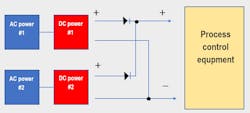Real-Time Process Control Needs High Reliability
What you’ll learn:
- When it comes to process-control systems, reliability is crucial and failure can be costly or dangerous.
- A combination of good design practices, component selection, and testing can enhance reliability.
- Redundancy is an additional tool for ensuring process-control reliability.
In process industries and applications requiring accurate real-time monitoring, control automation systems must be as failure-proof and degradation-proof as possible. Component choices and design practices can provide an extra measure of assurance and security. All of this must also be achieved within reasonable cost parameters.
Process-control system failures are usually relatively minor in nature and in their consequences, but they can result in cumulative losses that significantly impact businesses. And, of course, especially in industries involving inherently dangerous activities such as nuclear and petrochemical processing, process-control failures can lead to results like the Three Mile Island nuclear plant leak or the deadly Bhopal chemical disaster.
Importance of Reliable Process-Control Systems
A variety of methods exist to improve the reliability of systems. Improvements in process control and real-time monitoring always come at a cost and involve tradeoffs.
Designing for reliability can start at the inception of design. It’s rare for only one design to be able to provide a specific capability. Selecting the most reliable path involves considering design and component alternatives that can lead to increased reliability while maintaining a sense of potential costs. This process, if pursued thoroughly, often delivers significant reliability enhancements with a minimal cost impact.
Understanding the reliability of components and making appropriate choices can help ensure that equipment failures are rare. For example, wirewound resistors tend to be less failure prone than carbon composite resistors. Similarly, hermetically sealed semiconductor devices and polycarbonate or tantalum capacitors tend to have better reliability in their respective realms than the alternatives.
Another important but perhaps less obvious design tip is designing switches that stay in one position, preferably “on,” most of the time. This can greatly reduce both mechanical and electrical wear.
Reliability Strategy: Derating
Reliability of control systems involves melding system and hardware design as well as component selection. And those two functions can work together. For example, historically, the SAGE real-time air defense computer, developed in the 1950s, depended on thousands of notoriously unreliable vacuum tubes.
To ensure system reliability, tubes were “derated,” used at lower power. In addition, they were regularly replaced in hot-swappable modules on a schedule that usually anticipated component failure, ensuring nearly continuous uptime. Many (but not all) electronic and electrical components respond to lighter operational loading with longer service life. Using a more robust component than might be necessary is termed “derating” and can help reduce failures.
Derating should consider not only the electrical aspects of how a component will function, but also the operational temperatures, cooling mechanism, and other environmental factors. While these judgements will often need to be made through extrapolation from datasheets, there are some published derating studies for different kinds of devices and components.
The key question, of course, is the extent to which derating is likely to extend service life. Another question involves the tradeoffs between that “win” and increased costs or potentially a cumulative increase in component bulk or complexity.
Mean time between failure (MTBF) is another way of looking at the reliability challenge. Components with a higher MTBF are a good starting point and, of course, derating can often increase MTBF. That’s because it makes individual devices more likely to withstand unexpected transients or other challenges potentially causing failure in a component regularly operating just within its ratings envelope.
On the other hand, creating controls with derated components can make it more challenging to achieve design goals. For instance, a “derated” sensor may end up delivering less precision than expected.
This could suggest an alternative reliability approach, namely regular preventive maintenance and/or component or device replacement. In the example of the early air-defense computer described above, this was the expensive but successful strategy for achieving very high reliability from inherently unreliable technology.
Reliability Strategy: Redundancy
Redundancy is another approach to enhancing reliability, though perhaps the most costly and complex (see figure). This would typically be a matter of having whole circuits or functions existing in parallel with automatic failover. Or, the two alternative circuits could automatically “take turns” so that each receives similar use and wear and tear.
Testing, commonly called “burn in,” can also help identify any component that’s inadequate for the task. This could be part of the design process—ensuring component selection is optimal. And, burn-in before product deployment can provide a final level of assurance.
Finally, harking back to the design stage, considering the ultimate goal of more reliable process control, backup or overlapping means of measuring and monitoring a process could be considered. One example is direct temperature measurement with a thermal sensor supplemented by an indirect measure such as a proximate IR sensor. Though this would obviously increase complexity, it would provide not only redundancy but perhaps richer process control information, enhancing the value of the whole process control system.
References
“Process Control in Lean Six Sigma,” Techniques & Implementation.
“5Ps of Control System Reliability and Performance–Part 2: Preventive Maintenance,” Emerson Automation Experts.
About the Author



